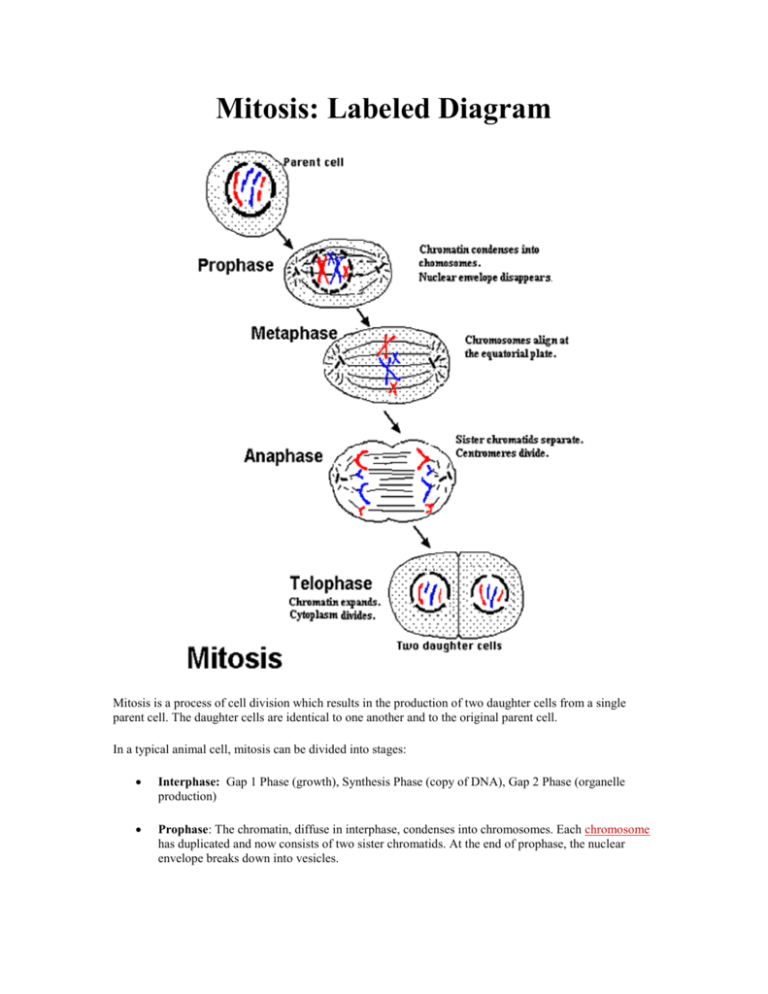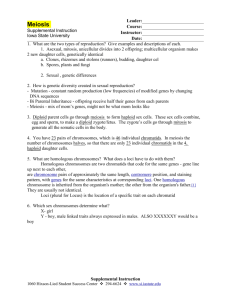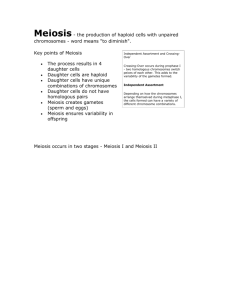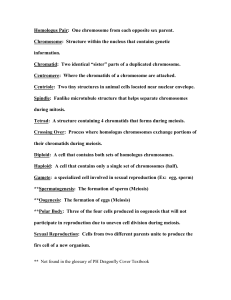Mitosis: Labeled Diagram
advertisement

Mitosis: Labeled Diagram Mitosis is a process of cell division which results in the production of two daughter cells from a single parent cell. The daughter cells are identical to one another and to the original parent cell. In a typical animal cell, mitosis can be divided into stages: Interphase: Gap 1 Phase (growth), Synthesis Phase (copy of DNA), Gap 2 Phase (organelle production) Prophase: The chromatin, diffuse in interphase, condenses into chromosomes. Each chromosome has duplicated and now consists of two sister chromatids. At the end of prophase, the nuclear envelope breaks down into vesicles. Metaphase: The chromosomes align at the equitorial plate and are held in place by microtubules attached to the mitotic spindle and to part of the centromere. Anaphase: The centromeres divide. Sister chromatids separate and move toward the corresponding poles. Telophase: Daughter chromosomes arrive at the poles and the microtubules disappear. The condensed chromatin expands and the nuclear envelope reappears. Cytokinesis: The cytoplasm divides, the cell membrane pinches inward ultimately producing two daughter cells Comparison of Meiosis and Mitosis 1. There are two divisions instead of one. 2. The chromosomes line up separately on the spindle for metaphase of mitosis, but at the first division of meiosis the chromosomes pair in a process called synapsis. In synapsis, homologous chromosomes pair tightly along their length and then move to opposite poles so that only one of each pair of chromosomes ends up in each cell after the first division. Meiosis Legend: Illustration of the process by which a single parent diploid cell (Both homologous chromosomes) divides to produce four daughter haploids cells (One homologous chromosome of the pair). Meiosis is the type of cell division by which germ cells (eggs and sperm) are produced. Meiosis involves a reduction in the amount of genetic material. Meiosis comprises two successive nuclear divisions with only one round of DNA replication. Four stages can be described for each nuclear division. First division of meiosis o Prophase 1: Each chromosome dupicates and remains closely associated. These are called sister chromatids. Crossing-over can occur during the latter part of this stage. o Metaphase 1: Homologous chromosomes align at the equatorial plate. o Anaphase 1: Homologous pairs separate with sister chromatids remaining together. o Telophase 1: Two daughter cells are formed with each daughter containing only one chromosome of the homologous pair. Second division of meiosis: Gamete formation o Prophase 2: DNA does not replicate. o Metaphase 2: Chromosomes align at the equatorial plate. o Anaphase 2: Centromeres divide and sister chromatids migrate separately to each pole. o Telophase 2: Cell division is complete. Four haploid daughter cells are obtained. One parent cell produces four daughter cells. Daughter cells have half the number of chromosomes found in the original parent cell and with crossing over, are genetically different. Meiosis differs from mitosis primarily because there are two cell divisions in meiosis, resulting in cells with a haploid number of chromosomes. Crossing-over and Recombination During Meiosis Crossing-over and Recombination During Meiosis Several different examples of how chromosomes can cross-over during meiosis. Figure Legend: Crossing-over can occur at one or more points along adjacent chromosomes, leading to an exchange of DNA. Such recombination may cause alleles that previously were on the same chromosome to become separated. For example, markers 1, 2, and 3 each have two alleles (a and b, c and d, e and f), and crossing-over occurs between markers 2 and 3.







